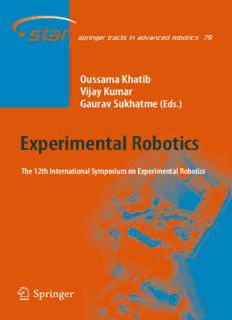Table Of Contentstar
springer tracts in advanced robotics 79
Oussama Khatib
Vijay Kumar
Gaurav Sukhatme (Eds.)
Experimental Robotics
The 12th International Symposium on Experimental Robotics
123
Springer Tracts in Advanced Robotics 79
Editors
Prof.BrunoSiciliano Prof.OussamaKhatib
DipartimentodiIngegneriaElettrica ArtificialIntelligenceLaboratory
eTecnologiedell’Informazione DepartmentofComputerScience
UniversitàdegliStudidiNapoli StanfordUniversity
FedericoII Stanford,CA94305-9010
ViaClaudio21,80125Napoli USA
Italy E-mail:[email protected]
E-mail:[email protected]
Forfurthervolumes:
http://www.springer.com/series/5208
EditorialAdvisoryBoard
OliverBrock,TUBerlin,Germany
HermanBruyninckx,KULeuven,Belgium
RajaChatila,ISIR-UPMC&CNRS,France
HenrikChristensen,GeorgiaTech,USA
PeterCorke,QueenslandUniv.Technology,Australia
PaoloDario,ScuolaS.AnnaPisa,Italy
RüdigerDillmann,Univ.Karlsruhe,Germany
KenGoldberg,UCBerkeley,USA
JohnHollerbach,Univ.Utah,USA
MakotoKaneko,OsakaUniv.,Japan
LydiaKavraki,RiceUniv.,USA
VijayKumar,Univ.Pennsylvania,USA
SukhanLee,SungkyunkwanUniv.,Korea
FrankPark,SeoulNationalUniv.,Korea
TimSalcudean,Univ.BritishColumbia,Canada
RolandSiegwart,ETHZurich,Switzerland
GauravSukhatme,Univ.SouthernCalifornia,USA
SebastianThrun,StanfordUniv.,USA
YangshengXu,ChineseUniv.HongKong,PRC
Shin’ichiYuta,TsukubaUniv.,Japan
N
SunTdAeRrth(SeparuisnpgiecresTorafcEtUs RinONAd(vEaunrcoepdeaRnoRboobtioctsi)cshRaessebaerecnhpNreotmwootrekd) RERuersoOepaeracBnhROO************TICS
NetworkU
E
·
Oussama Khatib Vijay Kumar
Gaurav Sukhatme (Eds.)
Experimental Robotics
The 12th International Symposium
on Experimental Robotics
ABC
Editors
Prof.OussamaKhatib Prof.GauravSukhatme
ArtificialIntelligenceLaboratory DepartmentofComputerScience
DepartmentofComputerScience UniversityofSouthernCalifornia
StanfordUniversity California
Stanford,CA USA
USA
Prof.VijayKumar
DepartmentofMechanicalEngineering
andAppliedMechanics
UniversityofPennsylvania
USA
ISSN1610-7438 ISSN1610-742X (electronic)
ISBN978-3-642-28571-4 ISBN978-3-642-28572-1 (eBook)
DOI10.1007/978-3-642-28572-1
SpringerHeidelbergNewYorkDordrechtLondon
LibraryofCongressControlNumber:2012937642
(cid:2)c Springer-VerlagBerlinHeidelberg2014
Thisworkissubjecttocopyright.AllrightsarereservedbythePublisher,whetherthewholeorpartof
thematerialisconcerned,specificallytherightsoftranslation,reprinting,reuseofillustrations,recitation,
broadcasting,reproductiononmicrofilmsorinanyotherphysicalway,andtransmissionorinformation
storageandretrieval,electronicadaptation,computersoftware,orbysimilarordissimilarmethodology
nowknownorhereafterdeveloped.Exemptedfromthislegalreservationarebriefexcerptsinconnection
with reviews or scholarly analysis or material supplied specifically for the purpose of being entered
and executed on a computer system, for exclusive use by the purchaser of the work. Duplication of
this publication or parts thereof is permitted only under the provisions of the Copyright Law of the
Publisher’slocation,initscurrentversion,andpermissionforusemustalwaysbeobtainedfromSpringer.
PermissionsforusemaybeobtainedthroughRightsLinkattheCopyrightClearanceCenter.Violations
areliabletoprosecutionundertherespectiveCopyrightLaw.
Theuseofgeneraldescriptivenames,registerednames,trademarks,servicemarks,etc.inthispublication
doesnotimply,evenintheabsenceofaspecificstatement,thatsuchnamesareexemptfromtherelevant
protectivelawsandregulationsandthereforefreeforgeneraluse.
Whiletheadviceandinformationinthisbookarebelievedtobetrueandaccurateatthedateofpub-
lication,neithertheauthorsnortheeditorsnorthepublishercanacceptanylegalresponsibilityforany
errorsoromissionsthatmaybemade.Thepublishermakesnowarranty,expressorimplied,withrespect
tothematerialcontainedherein.
Printedonacid-freepaper
SpringerispartofSpringerScience+BusinessMedia(www.springer.com)
Foreword
Robotics is undergoing a major transformation in scope and dimension. From a
largely dominant industrial focus, robotics is rapidly expanding into human envi-
ronmentsandvigorouslyengagedinitsnewchallenges.Interactingwith,assisting,
serving, and exploring with humans, the emerging robots will increasingly touch
peopleandtheirlives.
Beyondits impacton physicalrobots,the bodyof knowledgeroboticshaspro-
duced is revealing a much wider range of applications reaching across diverse
research areas and scientific disciplines, such as: biomechanics, haptics, neuro-
sciences,virtualsimulation,animation,surgery,andsensornetworksamongothers.
Inreturn,thechallengesofthenewemergingareasareprovinganabundantsource
ofstimulationandinsightsforthefieldofrobotics.Itisindeedattheintersectionof
disciplinesthatthemoststrikingadvanceshappen.
TheSpringerTractsin AdvancedRobotics(STAR)isdevotedtobringingtothe
research community the latest advances in the robotics field on the basis of their
significance and quality. Through a wide and timely dissemination of critical re-
searchdevelopmentsin robotics,ourobjectivewith this seriesis to promotemore
exchanges and collaborations among the researchers in the community and con-
tributetofurtheradvancementsinthisrapidlygrowingfield.
Sinceitsinception,theInternationalSymposiumonExperimentalRobotics(ISER)
waspublishedbySpringer.Sincethefourpasteditions,ISERhasfoundamoresuit-
able home under STAR, together with other thematic symposia devoted to
excellenceinroboticsresearch.
TheTwelftheditionofExperimentalRoboticseditedbyOussamaKhatib,Vijay
Kumar and Gaurav Sukhatme offers in its eight-chapter volume a collection of a
broad range of topics in field and human-centeredrobotics. The contentsof these
contributionsrepresentacross-sectionofthecurrentstateofroboticsresearchfrom
oneparticularaspect:experimentalwork,andhowitreflectsonthetheoreticalba-
sis of subsequent developments. Experimental validation of algorithms, concepts,
VI Foreword
ortechniquesisthecommonthreadrunningthroughthislargecollectionofwidely
diversecontributions,spanningfromcalibrationtograspingandmanipulation,from
novelsensorsandactuatorstolocomotionandmultirobotsystems,fromrobotmod-
ellingandobjectmodelingtomappingandtracking,fromhuman-robotinteraction
tomedicalandassistiverobotics.
From its warm social program to its excellent technical program, ISER culmi-
nateswiththisuniquereferenceonthecurrentdevelopmentsandnewdirectionsof
experimentalrobotics–kudostotheorganizersofthesymposiumandtheeditorsof
thisbook!
December2011 BrunoSiciliano
Naples,Italy STAREditor
Preface
The International Symposium on ExperimentalRobotics (ISER) is a series of bi-
ennialsymposiawhichbeganin1989,andissponsoredbytheInternationalFoun-
dation of Robotics Research (IFRR). ISER emphasizes experimental work while
providingthe roboticscommunity with a forum for presentingresearch driven by
creative ideas, bold visions, new systems, and novelapplications of robotics. The
traditioninISERistofosterscholarlyworkthateitheraddressesvalidationofthe-
oreticalparadigmsthroughcarefulexperimentationorcontributestothecreationof
novelexperimentalplatformsthatinturninspirenewtheoreticaldevelopments.The
ISERsymposiaareconceivedtobringtogetherinasmallgroupsettingresearchers
fromaroundthe world who are at the forefrontof experimentalroboticsresearch,
to assess and share their views and ideas aboutthe state of the art, and to discuss
promisingnewavenuesforfutureresearchexplorationinexperimentalrobotics.The
ISERmeetingsareorganizedaroundoralandinteractivetechnicalpresentationsin
asingle-trackformat.
TheTwelfthSymposiumwasheldonDecember18–21,2010inNewDelhiand
Agra, India. The symposium was chaired by Oussama Khatib (Stanford Univer-
sity,USA),VijayKumar(UniversityofPennsylvania,USA),andGauravSukhatme
(University of Southern California, USA). The local organizing committee was
chaired by Amarjeet Singh (Indraprastha Institute of Information Technology,
Delhi) and Sudipto Mukherjee (Indian Institute of Technology, Delhi). The Inter-
nationalSteeringCommitteeforISERischairedbyOussamaKhatibandincludes
Marcelo Ang (Singapore),Herman Bruyninckx (Belgium), Alicia Casals (Spain),
Raja Chatila (France),Peter Corke (Australia), Eve Coste-Maniere (France),John
Craig(USA),PaoloDario(USA),VincentHayward(Canada),GerdHirzinger(Ger-
many), Yoshihiko Nakamura (Japan), Paul Newman (UK), Daniela Rus (USA),
Kenneth Salisbury (USA), Bruno Siciliano (Italy), Sanjiv Singh (USA), James
Trevelyan(Australia),TsuneoYoshikawa(Japan),andAlexZelinsky(Australia).
The programof the Twelfth Symposiumincluded64 technicalpapers,selected
from open submission through a review process organized by the International
SteeringCommittee.Thesymposiumcontributionsreportonavarietyofnewthe-
oreticaland experimentalresults, and pointto new visions and trendsin the field.
VIII Preface
The topics of the technical sessions covered a broad spectrum of experimental
robotics research activities. For the first time, 20 papers were presented in inter-
active format on electronic displays. The symposium sessions were Human-robot
Interaction;Medicaland Assistive Robotics;Calibration;GraspingandManipula-
tion;MotorControlandLocomotion;RobotModeling,ObjectModelingandMap-
ping; Mapping and Tracking; Multirobot Systems, Novel Sensors and Actuators.
The program also included a special marble session overlooking the Taj Mahal.
This was structured as a lively open-air, Oxford-style debate on whether robotics
hadliveduptoitspromise.Thesession(chairedbyBernieRoth)includedfivedist-
inghuishedpanelists:RajaChatila,MattMason,BradNelson,RolandSiegwart,and
SanjivSingh.
This volume includes the complete collection of the contributions presented at
the symposium, with authoritative introductions to each section by the chairs of
thecorrespondingsessions.Wearegratefultotheauthorsandtheparticipantswho
have all contributed to the success of this symposium by bringing an outstanding
program, excellent technical presentations, and stimulating and insightful discus-
sions.Wewouldlikealsotoexpressourthanksandgratitudetothelocalorganizing
team who created the perfect environmentfor fostering technical discussions and
promotingintellectualdebatesinarelaxedsetting.
December23,2010 OussamaKhatib,StanfordUniversity
NewDelhi,India VijayKumar,UniversityofPennsylvania
GauravSukhatme,UniversityofSouthernCalifornia
Session Summaries
I. Human-RobotInteraction
AuthoredbySessionChair,WolframBurgard,UniversityofFreiburg
This section contained six papers covering several aspects of human-robot in-
teractionincludingforce-based,gesture-based,vision-based,andnaturallanguage-
based interaction. The first paper, presented by Wilm Decre, described a robot
programmingapproach for actively assisting humans in human-robotcooperation
tasks.Inthiswork,theoperatorandarobotjointlyexecutedmotionsviaforce-based
interaction.Inexperiments,theauthorsdemonstratethattheirapproachleadstosub-
stantially lower human-robot interaction forces compared to classical admittance
control.Thesecondpaper,authoredbyWataruTakanoandcolleagues,presentedan
approachforhumanoidrobostomakelinguisticinferencebyusinglanguageknowl-
edge stored in a dictionary.The authorsuse this capability for associating motion
patternsofhumans.ThethirdpaperwaspresentedbyThomasKollar.Itscontribu-
tionisaplanningframeworkthatenablesrobotstounderstandverbsofmotion.The
systemfollowsnaturallanguagecommandsbyfindingaplanthatminimizesacost
function which relates the language to the plan. In practical experiments, the au-
thorsdemonstratethattheirframeworkenablesrobotstorobustlyunderstandverbs
of motionin naturallanguagecommands.In the fourthpresentation,AmitKumar
Pandey described geometric and object-centered approaches to representing visi-
bility and reachability. He also presented different application scenarios in which
he demonstratesthe usefulnessof the approach.The fifth paper was presented by
NathanKoenig,whoreportedondifferentstudiesoftheimpactthattheusersvisual
accesstotherobot,orlackthereof,hasonteachingperformanceinalearningfrom
demonstrationsetting.Thepaperfurthermoredescribesinfluencediagrams,avari-
antBayesiannetworks,thatsupportsuchsettingsbyalsorepresentingthedecision
processin the graphstructure. The final presentationof this session was given by
JunaedSattar aboutan approachfordealing with communicationerrorsin human
robot interaction. The authors propose an unconventionalmodel for the risk of a
systemfailureandoftheassociatedrecoveryprocedurethatmaybeneededonthe
partofahumanoperator.
Description:The International Symposium on Experimental Robotics (ISER) is a series of bi-annual meetings which are organized in a rotating fashion around North America, Europe and Asia/Oceania. The goal of ISER is to provide a forum for research in robotics that focuses on novelty of theoretical contributions

